The first marine atomic tests on New Earth
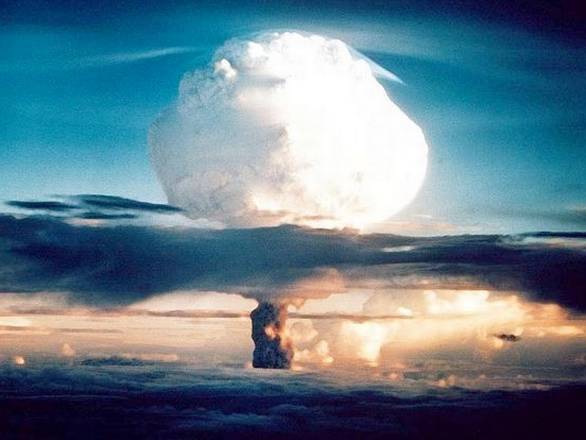
Post-war rearmament caused by the emergence of nuclear weapons, the widespread introduction of missiles for various purposes, the progress of radio electronics and automation, again led to an overestimation by the USSR leadership of the role of the military fleet in ensuring the security of the country. As a result of this, the ship program and plans for equipping the Navy were sharply reduced. aviation equipment, etc. However, our apparent lag behind the United States in improving atomic weapons, including naval weapons, required the expansion and acceleration of work in this area, which was greatly facilitated by the functioning of the Novaya Zemlya test site.
It is widely believed that this test site was created primarily for testing atomic and thermonuclear charges of high power. This is not entirely true. The landfill on Novaya Zemlya was intended primarily for testing naval weapons and studying the resistance of ships to the damaging factors of an atomic explosion. Therefore, it was called the “Marine Research Ground of the USSR Ministry of Defense”, and the test area was chosen only in the southern part of the Novaya Zemlya archipelago. At the same time, local residents (Nenets and Russian coast-dwellers) were relocated to a settlement specially built for them, remote from the landfill.
Only a few years later, when it became necessary to test high-power charges, it was necessary to expand the area of the test site and determine the locations of new combat fields. Since such fields were chosen to the north, it took a secondary resettlement of local residents, and now to the mainland. At the same time, in March 1958 of the year, the government decree reorganized the landfill from the sea to the State central test site for test charges and nuclear weapons of all types of aircraft.
In those years, the Directorate of the General Staff of the Navy was preparing tactical and technical specifications for atomic charges for artillery shells of large caliber, as well as for torpedoes of caliber 533 mm and the Kometa projectile. However, it should be noted that at that stage of development of a nuclear weapon, the formation of a supercritical mass of fissile materials created a crimp charge of an ordinary explosive of sufficiently large diameter. Therefore, the designers of these weapons could not yet realize all the orders of military sailors.
However, they took up charges for torpedoes. At the same time, the Ministry of Medium Machine Building (MSM) with the involvement of the Scientific Research Institute-400 of the Ministry of Industry and Food Industry, on its own initiative, began designing nuclear warheads for torpedoes of calibers 1550 and 533-mm. The giant torpedo was supposed to equip the projected nuclear submarine of the 627 project, and the torpedo of a standard caliber - diesel submarines. However, when considering the draft design of the 627, the fleet categorically refused to place a large torpedo on this boat, which was intended mainly to destroy coastal objects, and insisted on arming it with torpedoes of conventional caliber.
The difficulties of creating an atomic warhead in caliber 533 mm at that time can be judged by the fact that in August 1955 of the year, just six weeks before the scheduled deadline for testing this warhead by an explosion, Deputy Minister B.L. Vannikov proposed to move the tests to the next year. According to the forecast, the possible variation in power during a charge explosion represented a tenfold difference between its upper and lower limits. However, Admiral S.G. Gorshkov stated that he considered it impossible to transfer the test, because, due to the lack of data on the effect of the underwater atomic explosion on ships, the solution of fundamentally important issues in military shipbuilding is delayed.
By that time the formation and redeployment of a brigade of experimental ships to the New Earth was completed. It was replenished with ships of the Northern and Baltic fleets and consisted of 6 destroyers, 10 large hunters, 7 submarines, including German ones, 14 minesweepers of various projects, as well as two dry cargo vehicles. In addition, the brigade had a staff ship, and the landfill had a tank landing ship, tugs and other auxiliary vessels.
Technically, ships and brigade ships, with the exception of three obsolete Novik destroyers, were in a satisfactory condition. These ships were used in three large-scale experiments conducted to study the effects of the damaging factors of a nuclear explosion on ships and ships.
The first experiment was conducted 21 September 1955 of the year. The purpose of the tests was to check the atomic charge developed for the 533-mm torpedoes and obtain data on the effects of an underwater nuclear explosion on ships to develop preliminary recommendations for their protection. In this experiment, a torpedo with an atomic charge dropped on a cable from a specially equipped small minesweeper, project 253-L (“stotonnik”), to a depth of 12 meters. Unmanned target ships in all three experiments were mounted on barrels and anchors. The charge was undermined and the recording equipment was launched from a staff ship. The measuring equipment was located both on the ships and on the 20 floating stands of special construction.
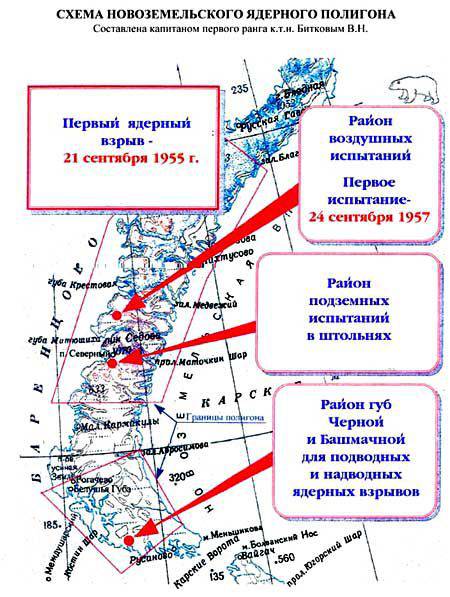
Testing was assigned to the Ministry of Defense (Navy) and the Ministry of Medium Machine Building, as well as the Academy of Sciences of the USSR. The State Commission included: the head of testing, Major General N.I. Pavlov (MSM), First Deputy Heads Rear Admiral PF Fomin (Navy) and Academician N.N. Semenov (USSR Academy of Sciences), Deputy Chief of Naval Technology, Captain 1, rank AK Popov. Rear Admiral N.D. Sergeyev, being the deputy head, was responsible for the maritime support and protection of the test area. The general leadership of the tests was assigned to the Commander-in-Chief of the Navy N.G. Kuznetsova. However, due to his illness, these duties were performed by Admiral S.G. Pots. The preparation of tests was directly supervised by Admiral I.E. Bass.
The interest in testing was so great that the Academy of Sciences and the Academy of Medical Sciences sent more than 120 scientists to them. According to the plan, target ships were located at a distance from 300 m to 3000 m from the epicenter of the blast. The test results of the first underwater atomic explosion were as follows: at a distance of 500 m and closer, the ships were completely disabled (one, the destroyer Reut sank), the submarine B-9, which was at a periscope depth of 600, slowly lose buoyancy, but after the return of personnel, it was brought into operational condition. On the remaining ships located on the test field at long distances, the damage was minor, disposable by personnel.
Difficulties arose in determining the power of the explosion. The methods that existed at that time were based mainly on estimating the parameters of the fireball, but it was impossible to use them for an underwater explosion. On the other hand, it was also difficult to use the parameters of the shock wave, since both underwater and air shock waves were formed.
The explosion used in the torpedo charge RDS-9 expected small power. Indeed, the sultan was hollow, and his radiation was even weaker than predicted. However, after its destruction, a base wave was formed, which, in the case of the ship covering it, was a strong damaging factor for the personnel, as it carried up to 80% of the radioactive products of an atomic explosion. In trials on ships, 75 dogs were placed, of which radiation sickness developed only in 12 animals. The rest did not suffer, except those who died on the ships of the near radius.
Tests have shown a high degree of damage to these weapons of ships in the case of their concentrated base, but rather its limited capabilities in terms of dispersal and in marching warrants. Although the torpedo with a nuclear warhead and had a large explosion power, but in the anti-nuclear warrant she was able to sink only one ship. In order to reduce the distance between ships in battle formations, it was considered necessary to increase the explosion resistance of certain weaker ship devices. It must be remembered that at that time they did not know all the negative effects of exposure to radiation.
This experience, during which received a semi-submersible, semi-air explosion, led to another conclusion. Lieutenant B.V. Zamyshlyaev promptly conducted a study showing that in the case of penetration of the same RDS-9 charge to a depth of more than 50 m (instead of 12 m), the striking effect should increase 1,5-1,7 times. The generalization of the results of the experiment and further studies of the phenomena of the underwater atomic explosion allowed Vice-Admiral Yu.S. Yakovlev and his staff to create a complete theory of this section of applied fluid dynamics.
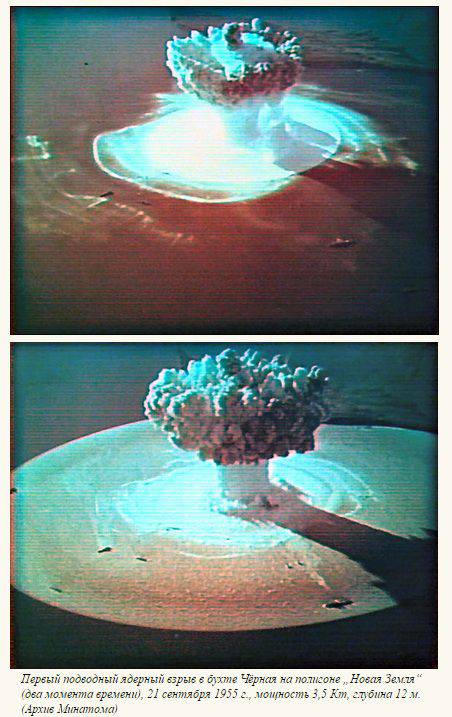
A second experiment was conducted on 7 September 1957. A government decree provided for an atomic bomb in 1956 to air in the air over target ships. To this end, the Navy had to carry out tests using specially-prepared target ships by the Ministry of Shipbuilding Industry (SME) 17. The scientific side of the experiment was assigned to the USSR Academy of Sciences (responsible - IV Kurchatov. NN Semenov). By that time, the Research Institute of the Navy, SMEs and the USSR Academy of Sciences began to insist that the ships participated in the tests, in connection with which, in July 1955, a directive of the command of the Navy appeared on preparation for testing a pair of destroyers of the 56 project 613 project and 50 project guard. A year later, the composition of the tested ships was clarified. Of the new ships, only destroyers Ave 30-k and 30-bis, as well as submarines Ave 613, were included in it. In addition to them, the cruiser "Admiral Makarov" (trophy "Nuremberg") stood out, but the Commander-in-Chief of the Navy S.G. Gorshkov considered it unacceptable to disable modern ships and insisted on using only BOC ships.
The charger was placed on a metal tower at the edge of the water. In these tests an unpleasant incident occurred. During the preparation of the test, exactly the 20 times were repeated control programs for automatic control of undermining and start-up of measuring equipment. There was not a single failure, but on 21, which was already in combat, a failure occurred, and there was no explosion. To clarify the reasons for the charge sent three experts who installed two fuses burned out. The first is on the receiver, and the second is on the transmitter. This was the first and last case of such a refusal. history Soviet nuclear weapons tests. Having established the reason, they reloaded all the films on the recording equipment, re-conducted a series of checks, completing them with a rehearsal. At the second attempt the charger exploded. Recorded data corresponded to the explosion of medium power ammunition. This value in TNT equivalent was later adopted as the “standard” for the implementation of measures for the ship’s anti-nuclear protection.
The ships were installed at six different deletions. In this case, two submarines (B-20 and B-22) were on the ground at a depth of 30 m, and the rest - in the surface position. As in the first experiment, the boiler and some of the auxiliary mechanisms worked on the “Thunder”. On it and on the T-218 were installed sections of the ships of new projects.
After the explosion, one of the submarines that were on the ground could not be lifted by the hitrojector. Since the case was filled with water. She was lifted by two 400-ton pontoons and stranded. Inspection by divers did not reveal any visible damage. The likely cause of flooding was the violation of the integrity of the outboard reinforcement.
The second submarine was lifted 75-ton kilector, blown tank main ballast. No damage was found, the boat fully retained combat capability.
The results of the impact of an atomic explosion on submarines that were in the surface position were also different. Submarine C-84 completely lost its combat capability. She could neither sink nor float, although her rugged hull did not receive any damage. The C-20 had minor damage to the light hull, which in no way reduced the combat capability and could be completely afloat eliminated by personnel. There was no damage on the C-19 submarine. He fully retained combat capability.
Various damage to superstructures, boiler covers, chimneys, ventilation shafts, antenna devices, etc. were noted on the destroyers. Engaged in the "Thunder" mechanisms worked fine. In general, the difference in the results of the impact of the damaging factors of the explosion on the operating and non-operating units and mechanisms was not observed.
Despite the fact that minesweepers were installed at the same distance from the epicenter, they received different damage. On Fedor Mitrofanov, who was left behind to the explosion, the superstructure was severely deformed. And on the T-219, facing the explosion, only the wheelhouse suffered. T-219 - received minor damage; "Peacock Vinogradov" - remained intact intact.
As a result of the Central Research Institute. A.N. Krylova comparing the calculations of safety radii with empirically obtained data revealed their difference: for destroyers - up to 30%, for trawlers - 150-200%. This is due to the great inequality of ship structures.
The air shock wave was the main cause of damage to ships. The effects of radiation on ships and personnel were found in a fairly limited area. Unfortunately, submarines capable of withstanding a shock wave, while on the surface, were unable to protect personnel from radiation exposure (up to the second degree), although it weakened 2-10 times inside the ships. The results of exposure to light on ships were weaker than expected - only the relatively dark paint burned.
The third experiment was carried out on 10 on October 1957. Its feature was that it was conducted in parallel with the state tests of the T-5 torpedoes, in the course of a nuclear attack by a torpedo from a submarine. The commission was chaired by admiral N.E. Bass. The head of the site during this period was Rear Admiral NL Lutsky. The submarine C-144 (Project 613) of the Northern Fleet fired from the distance 10 km. The difference in this test program of target ships was that an atomic munition was detonated at a depth of 35 m. It was impossible to increase the depth because of the relatively shallow water area.
The T-5 torpedo caused the testers a lot of trouble with their lack of reliability and complexity of the recording equipment launch system, which was supposed to fix the rapid processes. Even at the stage of its production tests, from 15 launches in 4 cases, the hydrostatic contactor prematurely worked, issuing a command to explode a warhead when the torpedo passed approximately the set distance. The reason was its unstable course in depth, which required reliable elimination of this drawback.
When a torpedo reached a given point, the rudders were shifted to the dive, at the same time turning off the engine, this is what the PGN recorded. In addition, the preliminary tests carried out by this system made it possible to quite accurately determine the time of the departure of a torpedo to a predetermined depth, and therefore, calculate the moment of the explosion in order to promptly turn on the recording equipment.
The test program included three sighting and control torpedo shots. Two without special warhead and one with warhead, but not containing fissile materials. The weight of the crimp charge is reduced, so as not to damage the PHN.
During the sighting shots, a number of comments were made, but the commission nevertheless decided to conduct combat shooting. The low reliability of the torpedo was compensated by the good reliability of the protection system of the warhead, based on the use of proven structures. So in an emergency situation (before the removal of protection) on the torpedo trajectory an explosion would not have occurred.
The T-5 combat shot was normal, the deviation from the target was of the order of 130 m (the accuracy of the optical method for determining the epicenter of the explosion reached 20 m). The TNT equivalent, determined from the pressures in the shock wave front, is estimated to be about the same order of magnitude as in the first experiment.
The results of the impact on submarines were as follows: C-84 (in the surface position at a distance of 250 m from the explosion site) - sank in less than a minute due to serious damage to the durable hull; C-20 (at the periscope depth at a distance from the epicenter in 310 m) - the damage caused a gradual filling of the feed compartments, the boat sank through the 4 hours with trim in 90 °; C-19 (was in a positional position at a distance in 520 m) - remained afloat, received severe damage to mechanisms and weapons, which made the boat completely inoperable; B-22 (located at a depth of 30 m in 700 meters from the epicenter) - no damage was found, the boat retained its combat capability.
The results of the experience on destroyers of the squadron were also different. “Grozny” (at a distance of 240 m from the explosion site) - quickly sank, even before the moment when the base wave dissipated. The destroyer "Enraged" (removed by 450 m from the epicenter) - received serious damage to the hull, stayed afloat for 4 hours. “Thundering” (at a distance of 650 m) is the only non-sunken destroyer, however, it took a significant amount of water and got a trim on the nose with a roll to the port side. After towing aground, divers noted severe hull damage.
An interesting result for the experimental section is identical to the destroyer of the project 56, which was located in the case of “Thundering”. Despite the presence of residual deformation, the section retained its water resistance, which demonstrated the advantages of welded structures over riveted ones.
The results of the experiment on minesweepers: T-218 (removed by 280 m from the epicenter) - sank within a few tens of seconds; “Peacock Vinogradov” (at a distance in the 620 m) - the hull did not receive any significant damage, but the weapon failed; T-219 (at a distance of 950 m) - had no damage, but fell into the zone of impact of the base wave. Having a move, he could evade and avoid radiation damage. Any ship with a speed of at least 15 nodes can always avoid the base wave.
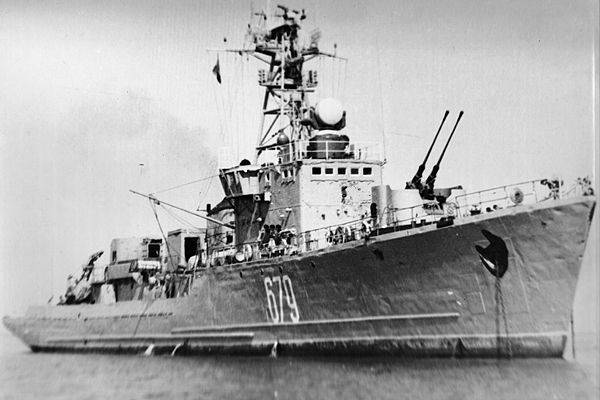
More field tests of this scale at the Novaya Zemlya test site was not conducted. As a result, they allowed to establish safe and critical sizes of removal radii for warships of three classes. Acquired reliable experimental data were used as the basis for calculations to improve the explosion resistance of ships that were built under the military shipbuilding program of those years.
Sources:
Dyachenko A. Scorched in the struggle to create a nuclear shield of the Motherland. M .: Polygraph-Service, 2008. C. 404-407.
Dumik V. Arctic Tests // Atom Press. 2009. No.36. C. 1, 4.
Shitikov E. Tests of ships on Novaya Zemlya // Sea collection. 1994. No. 6. C.74-77.
Shitikov E. In the interests of the fleet: Novaya Zemlya ... // Sea collection. 1994. No. 9. C.70-73.
Landfill "New Earth". 50 years. Documentary. 2004
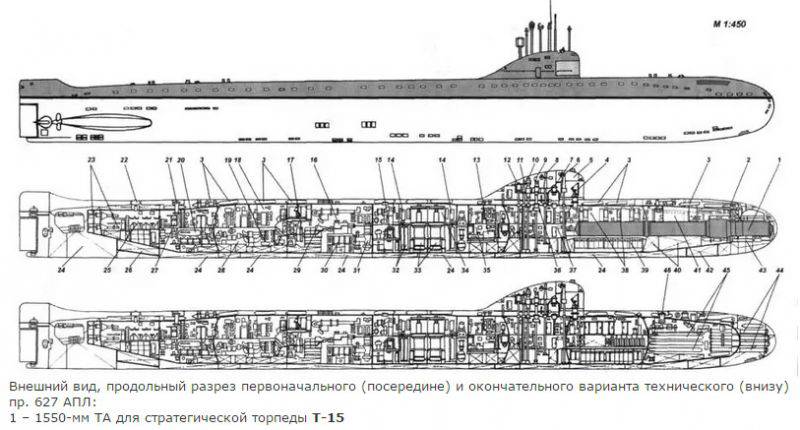
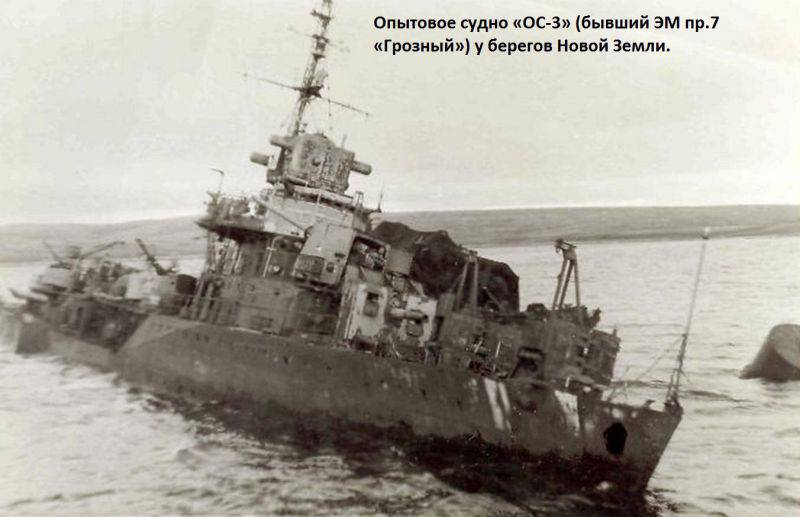
Information